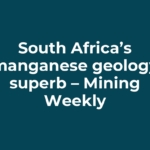Macozoma, Gilbertson signalling new era of manganese growth – Mining Weekly
Kathu, Northern Cape – One- time Robben Island prisoner Saki Macozoma is at the forefront of South Africa’s newest mine in an impoverished part of the Northern Cape province and Mining Weeky was in the sands of the Kalahari with him, as was mining luminary Brian Gilbertson , who has joined him in the manganese venture.
It was Gilbertson who turned South Africa’s former Gencor mining house into Billiton and then BHP Billiton, in time to meet the huge demand for metals and minerals from China.
Today, BHP Billiton is the world’s biggest and most profitable mining company.
Are Gilbertson and Macozoma seeing the future again, this time of strong ongoing demand coming through for the quality of manganese with which South Africa is blessed in the Kalahari manganese basin?
What the Witwatersand gold basin is to gold and the Bushveld Complex is to platinum, the 35-km-long and 15-km-wide Kalahari is to manganese.
The Tshipi Borwa project’s manganese is close to surface and can thus be mined relatively cheaply. The R1.7-billion funding for this unencumbered project is already done and dusted, and all in the form of foreign equity capital, with zero debt.
The black-controlled Ntsimbintle that Macozoma leads is 15% community owned, which gives it significant black economic- empowerment credentials.
With the first sod already turned at the proposed 2.4-million-ton-a-year Tshipi mine, the big issue ahead is logistics.
As one observer remarked: “This is really a big logistics project with a small mine attached.”
South Africa’s prized manganese resources will stand or fall by rail and port capacity and efficiency, which the State must provide.
Steel needs manganese and hardly any development takes place in the world without steel.
Moreover, the quality of China’s manganese is on the decline, which provides a window of opportunity for South Africa to fill the gap.
Also in the sands of the Kalahari for the sod turning was newly reinstated Transnet Freight Rail CE Siyabonga Gama, who says he is dealing with the logistics issue as a matter of national urgency.
Also in the Kalahari are other emerging black-empowered manganese mines, including the opencast United Manganese of Kalahari and the underground Kalagadi project, which will also be needing rail and port access.
While some in the industry have been advocating the conversion of the Sishen–Saldanha channel into a dual-commodity line, Gama is intent on turning the existing general freight line to Port Elizabeth, whence South Africa’s manganese is currently exported, into a heavy-haul line to the under-used deep-water Ngqura port, with the expectation that a manganese smelter will be built in the adjoining Coega industrial development zone.
Infrastructure as Catalyst
In the course of his long mining career, Gilbertson recalls witnessing the powerful impetus that infrastructure provision can give to a national economy on two milestone occasions.
The first was in Australia when, as the then BHP Billiton CEO, he cut the ribbon that signalled the start of a spurt of growth for iron-ore exports from the Pilbara.
“If you look at that date in 2002, you will see that it was before the big China boom,” Gilbertson says of his ribbon cutting at Mining Area C, in Western Australia.
“Fortunately, we had anticipated what was coming,” he told the audience that included parliamentarians, mayors and councillors.
With that investment in mining, the associated railway system and port infrastructure, he recalled that Australia succeeded in unlocking a huge opportunity and triggered a whole new era of growth.
From that date, iron-ore exports from Australia grew at a rate of 10% a year compounded, representing huge benefit to the country.
Unfortunately, South Africa was not equally prepared for the boom in China, and while Australia was achieving the 10% yearly growth, South Africa’s iron-ore growth was only 2% a year during the same period.
“It’s my first wish that our sod turning ceremony will trigger a new era of growth for South Africa’s exports in general, ahead of the coming increasing demand from China and the East and, in particular, that it triggers such a growth for manganese,” he adds.
The second experience was, as a boy in South Africa, witnessing his father’s involvement in the provision of water infrastructure for the developing Free State goldfields.
He recalls living in a small village of similar size to the settlement near the Tshipi mine, going to school barefoot and noticing the water infrastructure that his father was laying on, which contributed to new investment and an enthusiasm for com- mercial enterprise.
A strict new school principal turned his school career around and he was eventually awarded a university bursary that prepared him for entry into the mining industry.
His current hope is that the Tshipi project will bring similar opportunities to the youth of the area and also trigger an infrastructural catch-up that will enable South Africa to benefit from a new wave of Asian demand for high-quality manganese.
Quality Opening Doors
The quality of China’s manganese is in decline, which is opening the door for a new wave of high-quality South African ore to be exported to Asia.
The manganese content of South Africa’s Kalahari ore can be as high as 48%, while China’s is said to be largely below 20%.
The lower quality requires more electricity and China has electricity constraints, which provides an opportunity for greater South African supply.
Technically and geologically, South Africa has superb manganese that others can only dream about, says Singapore- based and ASX-listed OM Holdings CEO Peter Toth .
Independent manganese producer and marketer OMH holds 26% of Ntsimbintle and also owns a manganese mine in Australia’s Northern Territory and large sinter and alloy processing facilities in China.
“We can only dream about what you’ve got here in South Africa,” Toth tells Mining Weekly . “Large, thick, shallow homogenous continuous seams – it’s a dream from a mining and geological point of view. You’ve just got to get it to a port.”
Therein lies the rub. State-owned Transnet has been battling with the logistics, which are key to the competitive exploitation of 80% of the world’s manganese.
Can we gain a market share greater than the 15% currently held?
Tshipi director Finn Behnke n says Tshipi’s manganese deposit is as thick as 46 m in parts: “That’s like standing beneath a 16-storey building, glancing up and saying, right, that’s solid manganese ore,” he comments to Mining Weekly .
The average thickness is 30 m – the first 15 m is slightly lower in grade at 31,5% and the portion of ore below that – which forms the heart of the Tshipi orezone – has a manganese content of 37% and totals 163-million tons.
Manganese removes impurities, such as sulphur and oxygen, during the manufacture of steel. The use of manganese in steel also results in increased hardness, strength and resistance to impact and abrasion.
Railway tracks, for example, are made with steel that contains 1.2% manganese.
No satisfactory substitute for manganese in steelmaking has been identified, says Gilbertson.
Kalahari Manganese Field
The Tshipi Borwa mine is located on the southern outer rim of the Kalahari manganese field where ore resources are sufficiently close to the surface to make openpit mining practical. The ore layer dips gradually to the north-west at some 5°.
The 60-year life-of-mine Tshipi adjoins the long-standing Mamatwan manganese mine operated by BHP Billiton’s Samancor, with which Ntsimbintle is also in a 9% empowerment partnership.
Ntsimbintle has a strong international shareholding through Australian-listed Jupiter Mining and Singapore’s OMH.
The manganese lies 70 m below the present level of the Kalahari and requires the removal of 22-million tons of over- burden to access, says Tshipi GM Mokgosi Nkoana .
“This transaction will considerably strengthen trade ties between South Africa, Singapore and China and will be beneficial for all partners,” says Macozoma, who has been pursuing the development of the operation from its inception nine years ago.
Korean steelmaker Posco, which is part of the Pallinghurst coinvestor group, has an offtake agreement and Gilbertson recalls that Posco Africa MD Jung Seock Park , who was present at the Tshipi sod turning, was also present when he cut the ribbon in the Pilbara nine years ago.
Developing countries require significant amounts of manganese-containing steel in order to build infrastructure, which is essential for high economic growth rates.
Global steel production has accordingly increased from 847-million tons in 2000 to 1.4- billion tons in 2010.
Forecast demand for steel resulting from growth in the emerging markets and sustained demand from the established countries should support demand for the input raw materials.
Pallinghurst coinvestors formed Tshipi, a joint venture owned 50.1% by Ntsimbintle, the empowered consortium made up of the Macozoma-led Safika Resources, Nkojane Economic Prospecting and national and local economic development and community organisations and social trusts.
Tshipi also holds exploration rights to the Tshipi Bokone manganese prospect in the north of the Kalahari, with Tshipi Borwa – borwa meaning ‘south’ in Setswana and Sesotho – the key new-order mining rights asset.
The 400 km2 manganese field is said to contain 20-billion tons of manganese ore at grades of 20% to 48% manganese.
Observers say that the field’s size and geological simplicity render it the most important manganese resource in the world.
While Tshipi Borwa adjoins Samancor’s Mamatwan manganese mine, Tshipi Bokone is near Samancor’s Wessels underground manganese mine, which processes high-grade manganese ore.
Drilling has begun at Tshipi Bokone to evaluate a geological anomaly, which studies indicate is likely to contain high-grade manganese similar to that found at Wessels.
Rail Urgency
On increasing the capacity of South Africa’s manganese rail line to the Ngqura port, in the Eastern Cape, Gama says it is no longer a question of if, but one of how.
“There’s urgency for us to ensure that we unlock the logistics and make sure that we can facilitate export. Our view is that we need to ramp up capacity speedily in a year to 18 months,” he tells Mining Weekly .
He envisages an initial ramp-up to eight-million tons yearly capacity from the current four-million-plus tons a year, rising to 18-million by 2017 and later to 21-million tons a year.
Currently, manganese is railed along the general freight line to Port Elizabeth, but Transnet has indicated that it is committed to both expanding the level of exports and to vacating the existing manganese terminal at Port Elizabeth by 2017.
A converted heavy-haul line, he adds, would continue to carry general freight.
The concept of boosting the line dovetails with the proposed building of a manganese smelter at Coega by the empowered Kalagadi Manganese.
The dates are synchronised with the coming on line of Eskom’s new large Medupi and Kusile power stations to ensure that electricity is available for smelting and the attainment of government’s beneficiation goals.
Gama foresees Kumba remaining the dominant user of the Sishen–Saldanha line, along with Assmang and several emerging iron-ore miners who are likely to be ready to export mined product from 2014 to 2017.
Currently, the iron-ore line is able to cope with up to 60-million tons demand.
“We’ll have to be looking upwards of 86-million tons of annual capacity into the 90- million-ton mark for iron-ore within the next six to seven years.
“We need to work out how much should be invested and the quantum of the volumes. We should know by December what the cost will be, and that’s when we will decide on how we want to structure the financing,” Gama reports.
Cynthia Mogodi , chairperson of the John Taolo Gaetsewe Developmental Trust, which owns 15% of Ntsimbintle, emphasises the importance of the mine for the impoverished region.
“It is very important for our area, which is one of the poorest in South Africa,” she says.
Edited by: Martin Zhuwakinyu

